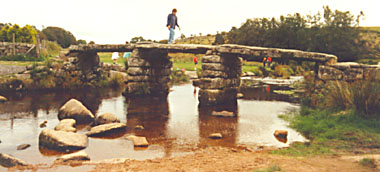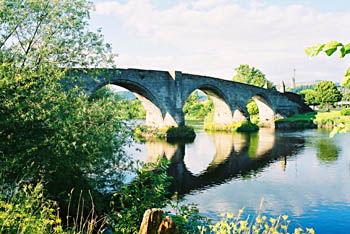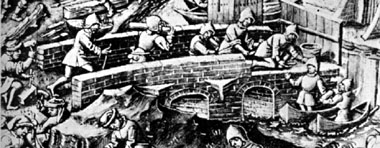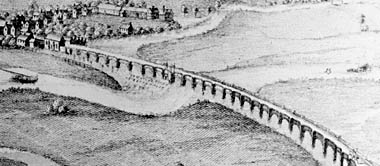
Clapper bridge at Postbridge, Devon.
Photo © S. Alsford
Bridges primarily served travellers and particularly commercial travellers such as merchants going from town to town, or peasants bringing produce or livestock to the nearest market town. Early travel relied mainly on fords – which could present problems if the river or stream was swollen with heavy rains, or if packhorses took it into their heads to cool off by rolling in the water – or small bridges wide enough only for pedestrians or packhorses to cross.
The clapper bridge above represents a late (13th or 14th century) example of a narrow bridge, built in part to facilitate the transportation of tin from Dartmoor mines to Tavistock. Other packhorse bridges were based on the more familiar arch construction, but were also narrow (e.g. those still existing at Wycoller in Lancashire, Wasdale in Cumbria, West Rasen in Lincolnshire, or others near Leicester). As long-distance trade picked up, the need for wider and sturdier bridges, such as that shown below, became more pressing.

The old bridge at Stirling. Although much in
the style of medieval bridges, this was built in 1745, near the remains
of the wooden bridge that featured in the famous battle of 1297.
Photo © S. Alsford
A huge amount of effort across England was required to construct and maintain the infrastructure necessary to support commerce. The construction of bridges was a challenging task, requiring provision of suitable materials, engineering expertise, and physical labour. Although much of the labour was provided by local communities, a significant part of the costs came from gifts or bequests from merchants, who stood to profit most from reliable bridges.

A bridge under construction in the 15th century.
Source: J. van de Gheyn, Croniques et Conquestes
de Charlemaine, Brussels, 1909, pl.95
Variations in bridge construction were necessitated by the landscape. On wide and flat flood plains a river might be very wide, or divided into several branches, necessitating long bridges, or multiple stretches of bridge connected by causeways, their route dictated in part by the location of solid river-bed or island between the branches, capable of bearing supporting piers. Such was the case at Nottingham, where a series of bridges crossed the Leen and Trent, as well as at Burton-on-Trent whose "Great Bridge" was 515 yards long.

Burton bridge
Source: Detail from an engraving by S. and N. Buck, ca.1730
full
image